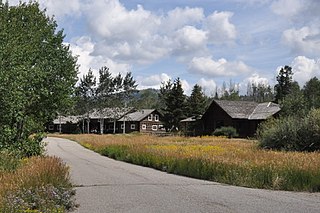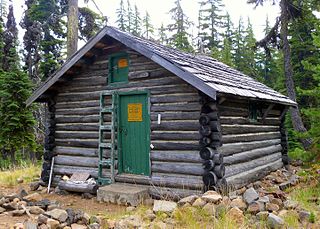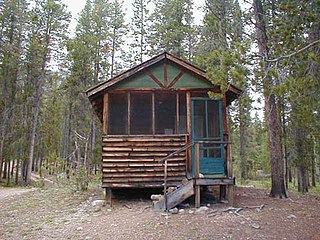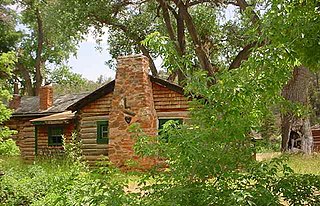
The Lake McDonald Lodge Historic District is a historic district in Glacier National Park in the U.S. state of Montana. It comprises the Lake McDonald Lodge and surrounding structures on the shores of Lake McDonald. It is centered on the main lodge, which was designated a National Historic Landmark in 1987, as well as surrounding guest cabins, dormitory buildings, employee residences, utility buildings, and retail structures. The district includes several privately owned inholding structures that are contributing structures, as well as a number of non-contributing buildings.

The AMK Ranch is a former personal retreat on the eastern shore of Jackson Lake in Grand Teton National Park. Also known as the Merymare, Lonetree and Mae-Lou Ranch, it was a former homestead, expanded beginning in the 1920s by William Louis Johnson, then further developed in the 1930s by Alfred Berol (Berolzheimer). Johnson built a lodge, barn and boathouse in 1927, while Berol added a larger lodge, new boathouse, and cabins, all in the rustic style.

The Ramshorn Dude Ranch Lodge in Grand Teton National Park was built after 1935 by mountaineers Paul Petzoldt, founder of the National Outdoor Leadership School, and Gustav Koven. The property that became the Ramshorn Ranch was originally established by Ransom Adams at the mouth of Gros Ventre Canyon near Ditch Creek. By 1921 the property was acquired by Jack and Dollye Woodsman, who established the Flying V dude ranch, featuring a large central lodge. In 1932 the lodge burned, prompting the Woodsmans to sell the ranch to Koven and Petzoldt in 1935, who planned to expand the dude ranch as a climbing school and hunting camp. Petzoldt withdrew from the partnership in 1937 after suggesting the name be changed to the Ramshorn Ranch. The present lodge was completed in 1937 by the Woodward brothers, who took over operation. A variety of owners and partners ensued until 1956, when the ranch was sold to the National Park Service. The Park Service then leased the ranch back to concessioners who operated it as the Elbo Ranch until 1973, replacing the former Elbo Ranch purchased by the Park Service. The Teton Science School was established on the property in 1974 under a special use permit.

The Manges Cabin in Grand Teton National Park, also known as the Old Elbo Ranch Homestead Cabin, Mangus Cabin and the Taggart Creek Barn, was built in 1911 by James Manges. Manges was the second settler on the west side of the Snake River after Bill Menor, setting up a homestead near Taggart Creek. James Manges arrived in Jackson Hole in 1910, where he cut wood for Charles or William Wort. Manges' cabin is stated to have been the first two-story structure in the northern part of the valley. A root cellar was excavated beneath. The log and frame structure features wide eaves to keep the winter snow away from the walls. It was heated in winter by a single stove, with one room on each level.

The Buckner Homestead Historic District, near Stehekin, Washington in Lake Chelan National Recreation Area incorporates a group of structures relating to the theme of early settlement in the Lake Chelan area. Representing a time period of over six decades, from 1889 to the 1950s, the district comprises 15 buildings, landscape structures and ruins, and over 50 acres (200,000 m2) of land planted in orchard and criss-crossed by hand-dug irrigation ditches. The oldest building on the farm is a cabin built in 1889. The Buckner family bought the farm in 1910 and remained there until 1970, when the property was sold to the National Park Service. The Buckner Cabin was listed on the National Register of Historic Places in 1974. The rest of the Buckner farm became a historic district in 1989. Today, the National Park Service maintains the Buckner homestead and farm as an interpretive center to give visitors a glimpse at pioneer farm life in the Stehekin Valley.

The Faraway Ranch Historic District is part of the Chiricahua National Monument in southeastern Arizona, and preserves an area associated with the final conflicts with the local Apache, one of the last frontier settlements, and in particular, its association with the people who promoted the establishment of the Chiricahua National Monument. Faraway Ranch is located in Bonita Canyon, which lies at an approximate altitude of 5160 feet and opens in a southwesterly direction into the Sulphur Springs Valley.

The Rial Chew Ranch Historic District comprises a ranching operation in what is now Dinosaur National Monument in northwestern Colorado, that existed from 1900 to 1949. The Rial Chew family established the ranch in 1900, operating it as a park inholding after the national monument was established in 1919. The district includes a house, a cabin, root cellar, corrals and several storage buildings. The cabin may have been built at Blue Mountain by Harry Chew, and moved to the present site by Jack Chew, Rial's father. The ranch was occupied by the Chew family until their special use permit expired in the early 1970s.

Honeymoon Creek Snow-Survey Cabin, also known as Seven Lakes Cabin, near Ashland, Oregon, was built in 1943. It was listed on the National Register of Historic Places in 2000.
The HF Bar Ranch is located in Johnson County, Wyoming about 20 miles (32 km) northwest of Buffalo, Wyoming in the foothills of the Bighorn Mountains near Saddlestring, Wyoming. The ranch is a working cattle ranch comprising about 36 buildings, built between 1898 and 1921. The ranch is associated with Wyoming state senator and U.S. Congressman Frank O. Horton, who purchased it in 1911 with financial help from his investment banker brother-in-law and sister-in-law, Warren and Demia Gorrell. The Gorrells and their children spent summers in Wyoming, while the Hortons stayed year-round.

The historical buildings and structures of Grand Teton National Park include a variety of buildings and built remains that pre-date the establishment of Grand Teton National Park, together with facilities built by the National Park Service to serve park visitors. Many of these places and structures have been placed on the National Register of Historic Places. The pre-Park Service structures include homestead cabins from the earliest settlement of Jackson Hole, working ranches that once covered the valley floor, and dude ranches or guest ranches that catered to the tourist trade that grew up in the 1920s and 1930s, before the park was expanded to encompass nearly all of Jackson Hole. Many of these were incorporated into the park to serve as Park Service personnel housing, or were razed to restore the landscape to a natural appearance. Others continued to function as inholdings under a life estate in which their former owners could continue to use and occupy the property until their death. Other buildings, built in the mountains after the initial establishment of the park in 1929, or in the valley after the park was expanded in 1950, were built by the Park Service to serve park visitors, frequently employing the National Park Service Rustic style of design.

The Holzwarth Historic District comprises a series of cabins built by the Holzwarth family as a guest ranch inholding within the boundaries of Rocky Mountain National Park, at Grand Lake, Colorado. The Holzwarths made their homestead in the Kawuneeche Valley in 1917, two years after the establishment of the park, and received a patent on the homestead in 1923. Guest ranch use began in 1919 and continued until the ranch was purchased by The Nature Conservancy in 1974. The property was transferred to the National Park Service in 1975 for incorporation into the park. The district comprises a number of rustic cabins on the Colorado River. Operations existed on both sides of the river, first known as the Holzwarth Trout Ranch and later as the Never Summer Ranch. All but Joe Fleshut's cabin have been removed from the east side of the river.

The Josie Bassett Morris Ranch Complex comprises a small complex of buildings in what is now Dinosaur National Monument in northeastern Uintah County, Utah, United States. The complex is listed as a historic district on the National Register of Historic Places. It is where Josie Bassett Morris, a small-time rancher and occasional accused stock thief, lived until 1963. The ranch, located in Browns Park, Colorado, was established by the Bassett family in the 1870s. Josie grew up there, and through her family came to know a number of outlaws, including Butch Cassidy, who frequented the area. Morris established her own homestead on Cub Creek in Utah in 1914 with help from friends Fred McKnight and the Chew family.

The Caroline Lockhart Ranch was established in 1926 by Caroline Lockhart, who purchased a 160-acre (65 ha) homestead near Davis Creek at the foot of the Pryor Mountains in Carbon County, Montana, while in her fifties. Lockhart expanded the ranch, adding buildings, land and grazing rights until the ranch comprised about 7,000 acres (2,800 ha). The region, known as Dryhead Country, is one of the most isolated places in Montana.

Derry Mining Site Camp was a mining site camp near Leadville, Colorado that operated during 1916–1923. It is located on the old Twin Lakes Toll Road, at an elevation of 9,320 feet (2,840 m). The placer mine was established on and named after the Derry Ranch established by Samuel Derry, who purchased the land in May of 1878. He homesteaded and farmed hay that was sold to feed the animals that worked in the gold rush operations in Leadville. When Derry died in 1889, his son Calaincourt Derry inherited the ranch and continued farming it until his death in 1908, at which time the ranch was sold to the Saguache Gold Mining Company, which began small-scale placer mining.
The Walter Cliff Ranch District, at 7635 Old HW 395 in Washoe Valley, Nevada is a historic site that was listed as a historic district on the National Register of Historic Places in 1985. It has significance dating from c.1870, when the house was built. The listing included two contributing buildings: the house and a root cellar/residence building.
The Braehead Ranch is a ranch complex in Converse County, Wyoming, about 17 miles (27 km) southwest of Douglas. The ranch is in a scenic landscape in the La Prele valley with a view of the red sandstone cliffs of Red Canyon. It was founded by George H. Cross in the 1880s. The original log homestead, built in 1883, has been preserved, together with contemporaneous ranch buildings. Contributing structures in the complex include a log barn (1887), a frame barn (1889), a granary (1900), a chicken house (1910), a windmill and a variety of smaller buildings. The main house dates to 1893-1897, of frame construction.
The Dorr Ranch was established by William and Mabel Dorr in 1910 in Converse County, Wyoming along Woody Creek. William had left home at the age of 8 or 9 and worked for the 71 Quarter Ranch and as a horse wrangler at Pony Express stations in Wyoming. He met Mabel McIntosh and married her in 1904. Mabel's parents had established the successful Hat Ranch near Split Rock and had significant resources to assist the young couple. The Dorrs filed for their first homestead in 1910 and expanded it in 1915, and again in 1917 and 1919, with a separate 1919 filing by Mabel. The Dorr's properties were not contiguous, and the present ranch house on Woody Creek was not built until 1915. In 1919 the Dorr School was built on the ranch. The same year the community of Bill was established, named after the shared name of four of the founders. The main ranch house was built in 1926–27.
The Bones Brothers Ranch, in the Tongue River Valley in Rosebud County, Montana near Birney, Montana, also known as the Z.T. Cox Ranch, was listed on the National Register of Historic Places in 2004.
The University Neighborhood Historic District is a 180 acres (73 ha) historic district near the University of Utah campus in northeastern Salt Lake City, Utah, United States, that was listed on the National Register of Historic Places in 1995.
The Salt Works Ranch, at 3858 U.S. Route 285 in Park County, Colorado near Hartsel, Colorado, was founded in 1862. The land is unusual for the presence of saline springs. It was listed on the National Register of Historic Places in 2001.














